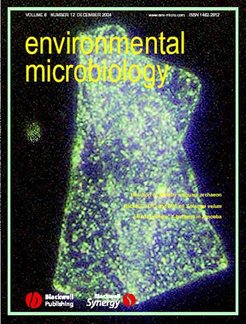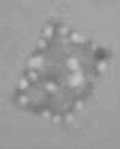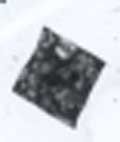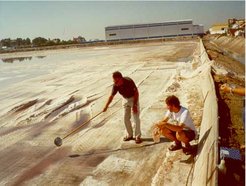Haloquadratum walsbyi
Introduction

Haloquadratum walsbyi (i.e. "salt square of Walsby") is the proposed name for the enigmatic square archaeon that is well known as "Walsby's Square Bacterium" and which was recently isolated into pure culture (H. Bolhuis et al., 2004). Microorganisms appear in many shapes and sizes, the majority of which are spherical, cylindrical or variations thereof, but only few of them are as appealing as this extreme halophilic square archaeon.

Using microscopy these rather large (2-5 µm), flat micro organisms are easily recognized by their perfect square morphology consisting of sharp edges and acute straight corners (Fig.1). Another eye-catching feature is the abundant presence of intracellular refractile bodies that were identified by Walsby as gas-vesicles (A.E. Walsby, 1980).

Based on its 16S rRNA sequence, 'H. walsbyi' is a member of a novel genus within the family of Halobacteriaceae. Although this square organism was already described in 1980 by its initial discoverer, Anthony Walsby, it resisted cultivation for almost 25 years. Despite the efforts of many researchers the squares stubbornly remained in the long list of unculturables. Its recent isolation from a Spanish crystalliser pond (H. Bolhuis et al., 2004) and the ability to cultivate this organism in large amount under relatively easy cultivation conditions enable us now to study it in great detail.
A second square archaeon was isolated from an Australian salt lake (D.G. Burns et al., 2004).
Ecology
Anthony Walsby observed the square cells for the first time in samples collected from salty puddles in the Sabkha Gavish in the south of Sinai that were used by Bedouin to collect solar salt. Thereafter it became clear that these peculiar cells could be observed in hypersaline waters all over the world. These ecosystems include natural and man-made ecosystems in which sea water evaporates, resulting in concentration and sequential precipitation of calcium carbonate and calcium sulphate, leaving a hypersaline sodium chloride rich brine. Further evaporation and concentration of these brines, the so called crystalliser ponds, result in the precipitation of sodium chloride (halite), whereafter a dense magnesium chloride brine called 'bittern' develops. At the last stage of halite formation, before the magnesium chloride brines get sterile, the squares dominate and can make up to almost 80% of the total microbial biomass. Growth of 'H. walsbyi' in medium containing up to 2 M of MgCl in addition to 3.3 M of NaCl and its abundance in the crystalliser ponds (J. Antón et al., 1999) shows that the square archaea are amongst the most halophilic organism
Genome analysis

Currently the 3.1 Mb large genome of 'Haloquadratum walsbyi' is being sequenced in a collaboration between H. Bolhuis (University of Groningen, The Netherlands), F. Rodríguez-Valera (Uníversidad Miguel Hernández, Alicante, Spain) and M. Falb, P. Palm, F. Pfeiffer, and D. Oesterhelt (Max-Planck-Institute of Biochemistry, Martinsried, Germany).
The Genome sequence will give us insight in the molecular eco-physiological properties of the square archaeon. These include the molecular basis for its square shape, and its ability to survive in its natural environment where it is exposed to extremely high salinities and high UV irradiation. Furthermore we will be able to unravel its metabolic properties providing us with clues as to why this organism was so difficult to cultivate in the first place.
References and further reading
- Bolhuis, H. , Poele, E.M. and Rodríguez-Valera, F. (2004) Isolation and cultivation of Walsby's square archaeon. Environ. Microbiol. 6, 1287-1291
- Walsby, A.E. (1980) A square bacterium. Nature 283, 69-71
- Antón, J. , Llobet-Brossa, E., Rodríguez-Valera, F. and Amann, R. (1999) Fluorescence in situ hybridization analysis of the prokaryotic community inhabiting crystallizer ponds. Environ. Microbiol. 1, 517-523
- Burns, D.G. , Camakaris, H.M., Janssen, P.H. and Dyall-Smith, M.L. (2004) Cultivation of Walsby's square haloarchaeon. FEMS Microbiol. Lett. 238, 469-473
- Stoeckenius, W. (1981) Walsby's square bacterium: fine structure of an orthogonal procaryote. J. Bacteriol. 148, 352-360
- Parkes, K. and Walsby. A.E. (1981) Ultrastructure of a gas vacuolated square bacterium. J. Gen. Microbiol. 126, 503-506
- Kessel, M. and Cohen, Y. (1982) Ultrastructure of square bacteria from a brine pool in southern Sinai. J. Bacteriol. 150, 85l-860
- Kessel, M., Cohen, Y. and Walsby, A.E. (1985) Structure and physiology of square-shaped and other halophilic bacteria from the Gavish Sabkha. In: Hypersaline Ecosystems. The Gavish Sabkha (Friedman, G.M. and Krumbein, W.E., Eds.), pp. 267-287. Springer-Verlag, Berlin.
Keywords
archaea ; archaeon ; brine ; crystallizer pond (crystalliser) ; gas vesicle ; genome sequencing ; haloarchaea ; halobacteriaceae ; halophile ; Haloquadratum walsbyi ; saltern ; square bacterium ; unculturable (previously) ; Walsby



